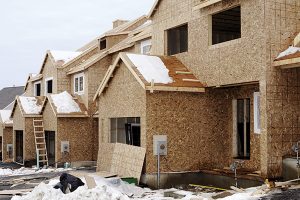
Feds new A Healthy Environment plan includes $2.6B for home owner energy efficiency grants
December 14, 2020 | By HPAC Magazine
The wide reaching clean energy plan also includes a proposed 100% tax write off for commercial light-duty, medium- and heavy-duty zero emission vehicles.

(Getty Images)
The Federal Government has unveiled more details on its efforts to promote healthy and energy efficient communities, including grants for home owners and working with the provinces/territories to create a new ‘retrofit’ code for existing buildings. Overall, the new federal A Healthy Environment and a Healthy Economy plan includes 64 new measures and $15 billion in investments in addition to the Canada Infrastructure Bank’s $6 billion for clean infrastructure announced earlier this fall.
A Healthy Environment and a Healthy Economy is designed to cut pollution, make life more affordable and create thousands of jobs in construction, technology, manufacturing and sales.
The government will:
- Invest $1.5 billion over three years for green and inclusive community buildings, and require that at least 10% of the funding be allocated to projects serving First Nations, Inuit and Métis communities.
- Provide $2.6 billion over seven years to help homeowners make their homes more energy efficient. This funding will provide grants of up to $5,000, up to one million free EnerGuide assessments, and support to recruit and train EnerGuide auditors.
- Continue working with and building on successful provincial and territorial low-income retrofit programs to increase the number of low-income households that benefit from energy retrofits.
- Continue to work with provincial and territorial governments to develop a new model ’retrofit‘ code for existing buildings, by 2022, with the goal of collaborating with provinces and territories to have this code in place by 2025.
- Develop a simple, low-cost loan program that integrates and builds on energy audits and grants to finance deeper home energy retrofits for homeowners.
- Work with the building materials sector and other stakeholders to develop a robust, low-emission building materials supply chain to ensure Canadian, locally-sourced products are available, including low-carbon cement, energy-efficient windows and insulation.
- Conduct Canada’s first-ever national infrastructure assessment, starting in 2021, to help identify needs and priorities in the built environment, and undertake long-term planning toward a net-zero emissions future.
- Invest $2 billion in financing commercial and large-scale building retrofits, which will be repaid by energy savings costs. This commitment is part of the CIB’s $10 billion Growth Plan.
The government will also expand the supply of clean electricity through investments in renewable and next-generation clean energy and technology, and encourage cleaner modes of transportation, such as low and zero-emission vehicles:
- Include the 100% tax write off for commercial light-duty, medium- and heavy-duty ZEVs.
- Invest an additional $287 million over two years to continue the Incentives for Zero-Emission Vehicles (iZEV) program until March 2022. The program provides a rebate of up to $5000 on a light-duty zero-emission vehicle.
- Invest an additional $150 million over three years in charging and refueling stations across Canada.
And to make clean, affordable electricity options more available, the government will:
- Invest an additional $964 million over four years to advance smart renewable energy and grid modernization projects.
- Invest an additional $300 million over five years to advance the government’s commitment to ensure rural, remote and Indigenous communities that currently rely on diesel have the opportunity to be powered by clean, reliable energy by 2030.
- Work with provinces and territories to connect parts of Canada that have abundant clean hydroelectricity with parts that are currently more dependent on fossil fuels for electricity generation.
Canada will continue elevating the price on carbon pollution. Moving forward, the government proposes to:
- Continue to put a price on pollution through to 2030, rising at $15 per tonne after 2022, while returning the proceeds back to households such that the majority receive more money back than they pay in provinces where the federal system applies.
The new plan includes programs aimed at large polluting industries and the agriculture sector. The vision also includes:
- Leveraging the Government of Canada’s purchasing power to support emerging clean technologies across Canada’s economic sectors, such as technologies to reduce emissions in federal buildings and reduce embodied carbon in construction materials.
- Work with small businesses to get their feedback on all potential ways to further support them in taking action to reduce emissions, including through rebates, targeted investments, and other supports.




